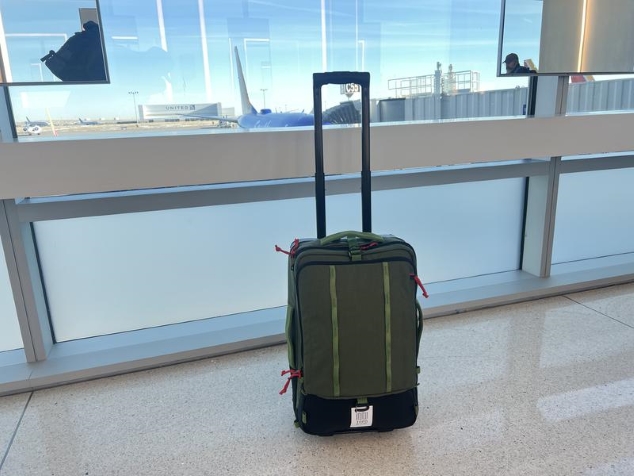Having the right type of luggage, pack or bag for your travels can make packing and hop on a plane or hitting the road easier and less stressful. But with so many styles, deciding which options is right for you can be a challenge. This guide breaks down the best types of luggage and how to pick the right size, weight and level of durability. It also goes over features like wheels, laptop compartments and carry-on compatibility.
A Practical Wheeled Bag

When on the hunt for the right style for your travel needs, let your luggage speak volumes with an easy-to-carry and quality wheeled bag. The obvious reason why more and more frequent travellers decide to go for this style is the advantage of how easy these are to transport through the airport and down smooth streets and sidewalks. When narrowing down your options, there are three types of wheeled luggage: rolling luggage, wheeled duffels and wheeled backpacks.
Designed for conventional travellers, rolling luggage is what you see most people pulling behind them in airports. These wheeled travel bags come in a variety of sizes and are normally built of durable materials designed to withstand the rigours of luggage transportation. They are ideal for business travel, family visits, road trips, and metropolitan excursions.
Nothing swallows gear like a duffel bag, and one with wheels is ideal for multisport travellers. If your trips frequently demand gear of various sizes and shapes, a rolling duffel is an excellent way to keep it all organised. For light packers, a carry-on wheeled duffel provides less capacity while eliminating the time and price of checking a bag. Wheeled duffels are ideal for adventurous travel with large or unusually shaped baggage, as well as family trips and road journeys.
Popular among adventurous travellers, wheeled backpacks combine the ease of wheeled luggage with the portability of a backpack. You can haul a lot of items with a single pull of the extensible handle. Are you facing considerable foot traffic or a long flight of stairs? Strap on the shoulder straps and hip belt for hands-free ease. These wheeled bags are ideal for adventure travel and road excursions.
The fundamental advantage of duffel bags is their straightforward design. They’re simple to use and typically include one huge compartment for carrying your goods and apparel. Of course, this could be a disadvantage if you’re the type that relies on different pockets and sections to stay organised. To stay organised in a duffel, put your belongings in travel cubes or stuff bags.
A duffel-wheeled bag comes in a variety of sizes, ranging from compact carry-on bags with a capacity and enough space for a weekend’s worth of clothes to larger duffels.
Size
The appropriate size of luggage, bag, or pack is determined by the length of the journey, the type of vacation, and your packing preferences. Purchasing a bag that is larger than you require may seem like a good idea, but we advise against it because you will be tempted to fill up any spare room you have.
If you are, however, planning a significant excursion that will necessitate the use of tents, sleeping bags, stoves, climbing gear, and other equipment, you’ll need a large bag (or several) to carry everything. However, if you’re going on a casual weekend break with only a few changes of clothes and toiletries, a compact bag would suffice.
Generally, luggage with a capacity of 50 litres or less is adequate for a weekend getaway. There are numerous carry-on duffels, packs, and bags in this size range to pick from. Many individuals choose this size bag for a one- to two-week excursion. For large expeditions, travellers usually require several large bags that can hold 75 litres or more apiece. Keep in mind, however, that the larger the bag, the heavier it is to carry. Multiple smaller bags may be easier to haul.
Weight and Durability
Whether you’re hoisting a bag into an aeroplane overhead compartment or hauling it up a flight of stairs, hefty luggage makes travel more difficult. Furthermore, with most airlines charging surcharges for bags weighing more than 50 pounds, it is in your best advantage to keep your luggage modest.
The weight of the bag alone can be important if you’re approaching the 50-pound limit or simply want to keep your baggage as light as possible. A large suitcase may not be a major worry if you’re travelling from the airport to a hotel with smooth rolling surfaces. But if you’ll be lifting and carrying bags frequently, a lighter is preferable.
From rough baggage handlers to bumpy travel on difficult roads, your luggage and its contents might take a beating. Thinking about the longevity of luggage, packs, and bags entails inspecting the materials used to construct each piece as well as evaluating factors like zippers, wheels, and handles. If the safety of the goods within your suitcase is your top consideration, choose hard-sided baggage. These are typically made of lightweight, impact-resistant polymers. Aluminium luggage, on the other hand, offers good protection, but it is heavy and expensive.
If you require a waterproof bag and have opted for a duffel, look for high-denier rip-stop fabrics coated in thermoplastic urethane for the highest durability and water resistance.





Comments are closed.